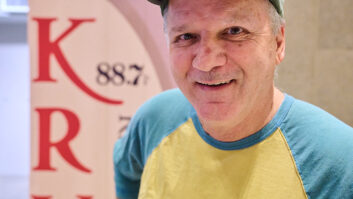I hosted a Radio World webinar recently about news and trends of interest to engineers and managers.
It was fascinating to put that project together. For those who couldn’t attend, here’s a taste of the topics that we discussed. The webinar is archived free, online, if you’d like to see it in full.
Fraunhofer, the German institute that developed MP3 and AAC, recently introduced MPEG 4 AAC Enhanced Low Delay.
This is an improvement on an algorithm used for video teleconferencing and other applications. The new version offers even lower delay — down to 15 milliseconds — and it allows the same audio quality at about half the bit rate. It combines the benefits of MPEG Low Delay AAC and Spectral Band Replication.
That’s full audio bandwidth, suitable for speech and music, that can be transmitted for instance over IP connections at very low delay. The promise here is of “high audio quality, low coding delay and very low data rates” for delay-critical applications that need full audio at data rates down to 24 kilobits per second per channel.
We’re told by people who know that this will quickly become the industry standard for low-delay IP codecs. It already has been adopted by major codec companies including Comrex, Telos Systems and Mayah.
* * *
Everyone, it seems, is into audio over IP.
Not just IP-based consoles and routers, but facility and transmitter control, monitoring, on and on. You can hardly walk the aisles of the spring NAB show without seeing an introduction with IP in the name. This is the gradual migration of nearly everything to IP-based platforms, and it has implications for engineers because as “the melding of IT and traditional radio engineering continues.”
(click thumbnail)The economy’s impact on capital expenditures was among topics discussed in the webinar. © Shutterstock.com There’s a great deal of power and cost efficiencies for engineers in using both the Internet and IP interconnection. These “communication busses” not only are saving money for stations in leasing fees but they allow more throughput of audio channels, as well as control data and telemetry. And the Internet allows an engineer the convenience of doing his or her job from various locations while getting real-time feedback through the browser.
When I ask my experts, “What do you feel is the most notable technology trend that is reflected in radio broadcast product design,” most answer with some variant of “the inclusion of an IP port on hardware.” (The USB port comes in a close second; some also mention super-high-speed DSP processing chips, though that’s been an ongoing trend.)
* * *
The economy has very much affected both stations and suppliers.
It has slowed equipment purchases in general and the HD Radio rollout of the larger companies specifically — though it’s important to note that these days, middle and smaller radio markets tend to be less hard hit in terms of relative impact on revenue of the economy. (For investors, business analysts say right now the best predictor for radio revenue is market size, not regional or group differences.)
I hear that many capital projects are “on hold” or deferred pending some improvement. “Particularly disturbing,” according to one engineering observer, is what seems to be yet another round of drastic technical staffing cuts at organizations that have already cut such positions deeply in the past.
U.S. commercial radio should see some financial benefit from the presidential election, of course. But there’s no question capital projects continue to be a challenge.
That’s also true in public radio; one chief told me his biggest concern is handling RF, IT and cost issues associated with IBOC installations. “I remain very concerned that IBOC will not pay for itself, even with the low-cost licensing for noncom educationals,” he said.
But another, well known engineering consultant told me recently his clients are upbeat in part because they’re working actively to develop all their alternative delivery streams, the kind of thing RW covered in our recent supplement “Radio in the Post-iPod Era.”
Over time, he thinks we will see “changes in how stations are valued that relate to their ability to tie into alternative methods of program delivery.”
* * *
Mobile TV is at the top of the agenda for TV broadcasters and it’s important for radio too. The technology has been proven to work; and a standard for adding mobile TV to broadcasters’ DTV services is being fast-tracked in time for roll out in coordination with the analog TV shutoff next February.
The window of opportunity is narrow. Broadcasters are rushing to launch mobile TV services that are already offered by cell carriers such as Verizon and AT&T.
Video is just one part of the equation. Most any data can be sent along the DTV bitstream, and the ability to send this data to moving vehicles, cell phones, public transit systems and so forth will open business opportunities for TV broadcasters — and more competition for radio in the portable world.
In addition to video, services such as digital signage, software updates, GPS, traffic reports and emergency alerts are some that television broadcasters could tap when considering how to monetize this. The mobile TV market could be a $2 billion market by 2012, according to a study commissioned by NAB.
The jury remains out on whether TV broadcasters will want to adopt mobile TV services. They are going to need to be confident of the ROI. Adding data to the DTV bitstream means more data to an increasingly crowded signal that offers secondary DTV channels in addition to the HDTV signal.
Broadcasters’ priority is their main signal. If such services are available in their particular market, they may think twice about offering it if the market is too crowded (and they can’t distinguish their service from others).
But this bears watching.
* * *
Something else people were talking about: Adobe Flash now supports MPEG AAC-HE.
I was talking to Steve Church at Telos Systems, who is very good at watching for how this kind of thing affects radio.
He says AAC-HE is the best codec out there; and Flash is everywhere, with even more penetration than the Windows Media player. So he thinks this development will be a big boost to streaming.
There have been many player types, and much incompatibility. Flash seems to offer the best of all worlds; it now supports this powerful music codec; it has something like 98 percent penetration; it is available on PC, Mac and Linux.
YouTube and almost all of the online video services use it; and Flash offers big player programming opportunities, with audio, video and locally programmed and rendered animation and hi-rez text.
A station could stream video clips and text and graphics to accompany the audio. Because it can run applications locally, it can be interactive; so clicking a button can cause things to happen. You don’t get this with Windows Media or Winamp.
Radio needs to pay attention to streaming developments. Groups are making money off streaming ads, and with the 3G iPhone announced and WiMax in the wings, streaming to mobile devices might be coming as something mainstream.
Church puts it this way: “A portable ‘radio’ with an iPhone user interface and a thousand channels is a paradigm shifter and an opportunity. Shouldn’t broadcasters be on board?”
* * *
Other developments discussed in the webinar include the change in standard wiring topology at radio stations; the recent launch by major radio groups of a consortium to create a nationwide terrestrial broadcasting network to distribute traffic and other map-related data; and plans for an “extreme makeover” of the Las Vegas Convention Center (but you already know about that from our story on page 30 of our April 9 issue).
You can watch the free hour-long webinar by clicking on the logo for “25 Things You Might Have Missed at the NAB Show” at www.radioworld.com/webinar-archive.shtml. Thanks to our sponsors Broadcast Electronics, Harris and Nautel.
PS — Although the spring show served as a “news hook” for this webinar, we covered a great deal of news and products that are of interest quite apart from the convention.













